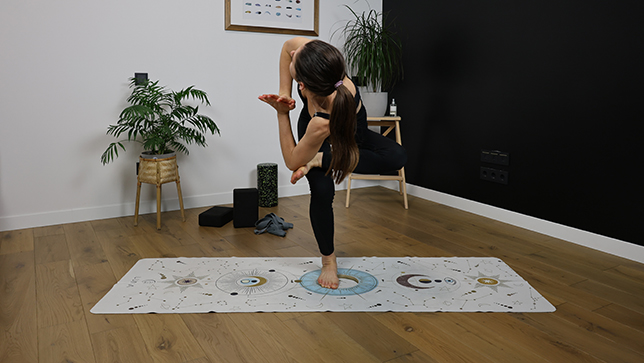Twist Half Chair Pose - Parivrtta Ardha Utkatasana Twist Half Chair Pose

Contents
Twist Half Chair Pose, also known as Parivrtta Ardha Utkatasana, is a pose that challenges your balance, strength, and flexibility. This asana requires a stable foundation and a deep connection to your core as you balance on one leg while twisting your torso.
The name of this pose originates from Sanskrit. “Parivrtta” translates to “revolved” or “twisted,” “ardha” means “half,” “utkata” denotes “difficult,” “fierce,” or “intense,” and “asana” refers to “posture” or “pose.”
In addition to the physical benefits, which include a powerful stretch along the spine, Parivrtta Ardha Utkatasana is believed to be invigorating and effective in reducing stress and anxiety. As a revolved posture, it is also thought to stimulate the manipura (navel or solar plexus) chakra, which is associated with confidence, self-esteem, and transformative energy.
Pose Detail
- By Type: Balancing Yoga Poses, Flexibility Yoga Poses, Hip Opening Yoga Poses, Strengthening Yoga Poses
- Difficulty: Beginners, Intermediate
- Body Position: Standing Yoga Poses, Twist Yoga Poses
- By Benefit: Yoga Poses For Digestion, Yoga Poses For Stress Relief
Step-by-Step Instructions
Benefits and Contraindications
Massages the internal organs, especially the digestive organs
Strengthens and stretches the legs, hips, and spine
Enhances digestion and detoxification
Improves balance and coordination
Stimulates the nervous system
Boosts energy and reduces fatigue
Increases mental focus and concentration
Spinal injuries or conditions that limit spinal mobility or twist
Knee, ankle, or hip injuries
Pregnancy, especially during the second and third trimesters
High or low blood pressure
Migraine or headaches
Vertigo or dizziness
Modifications and Props for Beginners
- Place your lifted foot on your calf instead of your thigh to make the pose easier.
- Use a wall for support: Stand with your back against a wall and come into Utkatasana with your feet hip-width apart. Lift one foot off the ground and place it on your opposite thigh. Place your hands on the wall for support as you twist.
- Use a chair: Stand behind a chair and come into Utkatasana with your feet hip-width apart. Lift one foot off the ground and place it on your opposite thigh. Place your hands on the back of the chair for support as you twist.
Useful Tips
- Keep your weight in your heels as you come into Utkatasana and lift your foot off the ground.
- Engage your core and lengthen your spine to maintain your balance and avoid rounding your back.
- Twist from your waist and chest, not just your shoulders, to deepen the twist.
- Breathe deeply and evenly, using your breath to help you stay focused and calm.
Frequently Asked Questions
Common mistakes to avoid in Parivrtta Ardha Utkatasana include collapsing the chest, rounding the shoulders, and losing the connection between the lower body and the twist. It is important to keep your chest lifted and shoulders relaxed, while also engaging your core muscles to maintain stability.
Yes, beginners can practice Parivrtta Ardha Utkatasana, but it is important to start with the preparatory poses and to listen to your body. It is recommended to work with a qualified yoga instructor to learn the proper alignment and modifications.
No, Parivrtta Ardha Utkatasana may not be safe for everyone. If you have a back or knee injury, or if you are pregnant, you should consult with a qualified yoga teacher before attempting this pose.
You can hold Parivrtta Ardha Utkatasana for 5-10 breaths on each side. It is important to listen to your body and not push yourself too far beyond your limits.